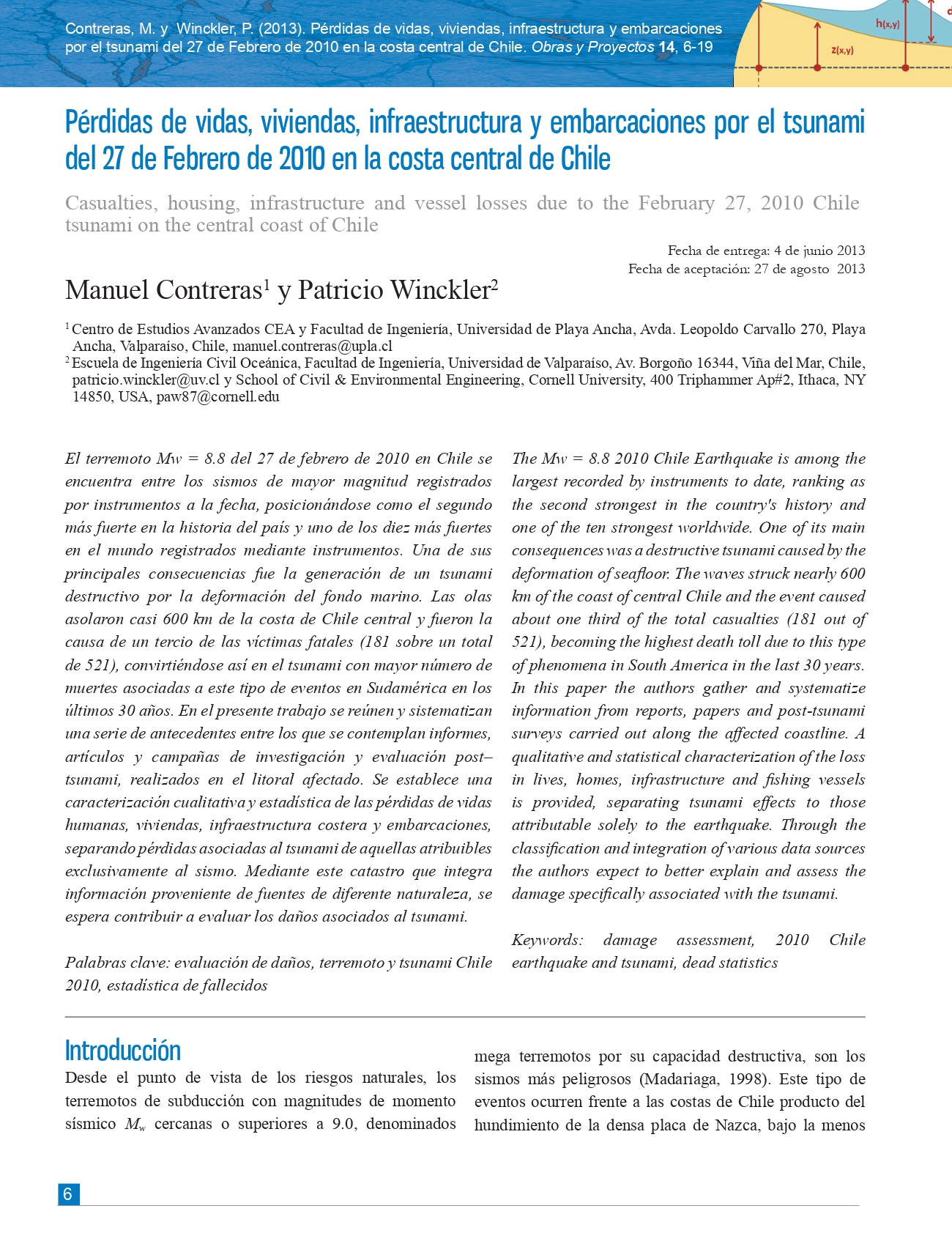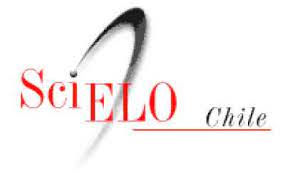Casualties, housing, infrastructure and vessel losses due to the February 27, 2010 Chile tsunami on the central coast of Chile
DOI:
https://doi.org/10.4067/S0718-28132013000200001Keywords:
damage assessment, 2010 Chile earthquake and tsunami, dead statisticsAbstract
The Mw = 8.8 2010 Chile Earthquake is among the largest recorded by instruments to date, ranking as the second strongest in the country's history and one of the ten strongest worldwide. One of its main consequences was a destructive tsunami caused by the deformation of seafloor. The waves struck nearly 600 km of the coast of central Chile and the event caused about one third of the total casualties (181 out of 521), becoming the highest death toll due to this type of phenomena in South America in the last 30 years. In this paper the authors gather and systematize information from reports, papers and post-tsunami surveys carried out along the affected coastline. A qualitative and statistical characterization of the loss in lives, homes, infrastructure and fishing vessels is provided, separating tsunami effects to those attributable solely to the earthquake. Through the classification and integration of various data sources the authors expect to better explain and assess the damage specifically associated with the tsunami.
References
Aránguiz, R. (2010). Modelación numérica del tsunami 2010 en la Bahía de Concepción utilizando deformación inicial estática no uniforme, Obras y Proyectos 8, 12-18
Astroza, A., Moroni, O., Brzev, S. and Tanner, J. (2012). Seismic assessment of engineered masonry buildings in the 2010 Maule Earthquake. Earthquake Spectra 28, No. S1, S385-S406. https://doi.org/10.1193/1.4000040
Barrientos, S. (2010). Terremoto (m=8.8) del 27 de febrero de 2010 en Chile. Revista de la Asociación Geológica Argentina 67(3): 412-420
Benedetti, S. (2011). El terremoto más grande de la historia. Valdivia-Chile, 22 de mayo de 1960. Origo Ediciones, Santiago
Betanzo, R. (2010). Daños estructurales y lecciones del terremoto del 27/F en el Gran Concepción. Obras y Proyectos 8, 59-75
Bitar, S. (2010). Doce lecciones del terremoto chileno. Estado, Gobierno, Gestión Pública. Revista Chilena de Administración Pública 15 - 16: 7-18. https://doi.org/10.5354/0717-8980.2010.11205
Bresciani, L. (2010). Chile 27F 2010: La catástrofe de la falta de planificación. EURE. Volumen 36, Número 108: 151-153. https://doi.org/10.4067/S0250-71612010000200007
Bray, J., Rollins, K., Hutchinson, T., Verdugo, R., Ledezma, C., Mylonakis, G., Assimaki, D., Montalva, G., Arduino, P., Olson, S.M., Kayen, R., Hashash, Y. and Candia, G. (2012). Effects of Ground Failure on Buildings, Ports, and Industrial Facilities. Earthquake Spectra 28, No. S1, S97-S118. https://doi.org/10.1193/1.4000034
Brunet, S., de la Llera, J. C., Jacobsen, A., Miranda, E. and Meza, C. (2012). Performance of Port Facilities in Southern Chile during the 27 February 2010 Maule Earthquake. Earthquake Spectra 28, No. S1, S513-S532. https://doi.org/10.1193/1.4000022
CEPAL (2010). The Chilean earthquake of 27 February 2010: an overview. United Nations publication. 2010-191, Santiago
Cereceda, P., Errázuriz, A.M. y Lagos, M. (2011). Terremotos y Tsunamis en Chile. Origo Ediciones, Santiago
Cisternas, M.E. (2011). Responsabilidad social de los geocientistas en el manejo de riesgos: Enseñanzas derivadas de la experiencia chilena con el megaterremoto del 27 de febrero 2010. GOAL 2011: Geo-Risk Management a German-Latin American approach. Heidelberg, pp: 19-24, http://www.goaldaad.com.ar/goal/images/documentos/pubgoal2011.pdf (enero 2013)
CONAPACH (2010). Diagnóstico de los impactos del terremoto y tsunami del 27 de febrero de 2010 en la pesca artesanal en Chile. Confederación Nacional de Pescadores Artesanales de Chile. http://www.conapach.cl/home/archivos/informe%20final.doc (abril 2012).
Contreras, M., Winckler, P. y Urbina, L. (2012). Área de inundación y efectos del tsunami del 27 de febrero de 2010 en la localidad de Llolleo, San Antonio - Chile (33°36.5''s). Revista Geográfica de Valparaíso, N° 46: 69-81.
D'Ayala, D. and Benzoni, G. (2012). Historic and traditional structures during the 2010 Chile Earthquake: Observations, codes, and conservation strategies. Earthquake Spectra 28, No. S1, S425-S451
EERI (2010). The Mw 8.8. Chile Earthquake of February 27, 2010. Special Earthquake Report. http://www.eeri.org/site/images/eeri_newsletter/2010_pdf/Chile10_insert.pdf (abril de 2013)
EM-DAT (2012). Emergency Events Database. Centre for Research on the Epidemiology of Disasters (CRED), School of Public Health of the Université Catholique de Louvain. http://www.emdat.be/ (mayo de 2013)
Fariña, J., Aragoneses, N., Armesto, S., Almar, R., Bertness, M. y Silliman, B. (2010). Cambios en la estructura de hábitat de la Laguna Albufera, Humedal El Yali (V Región), luego del tsunami del 27 de Febrero del 2010. Boletín 01 Red Universitaria Cruz del Sur, Capítulo Ciencias del Mar. http://copas.udec.cl/eng/news/Boletin_RUCS_01.pdf (febrero 2012).
Fariña, L.M., Opaso, C. y Vera-Puz, P. (2012). Impactos ambientales del terremoto y tsunami en Chile. Las réplicas ocultas del 27F. Fundación Terram, Santiago
Fiscalía (2011). Nomina de fallecidos y desaparecidos por el tsunami. Disponible en línea (fecha de visita febrero 2012): http://www.fiscaliadechile.cl/Fiscalia/sala_prensa/noticias_det.do?id=125
Fritz, H., Petroff, C., Catalán, P., Cienfuegos, R., Winckler, P., Kalligeris, N., Weiss, R., Barrientos, S., Meneses, G., Valderas-Bermejo, C., Ebeling, C., Papadopoulos, A., Contreras, M., Almar, R., Domínguez, J. and Synolakis, C. (2011). Field Survey of the 27 February 2010 Chile Tsunami. Pure and Applied Geophysics 168: 1989-2010
Gobierno (2010). Programa de Reconstrucción Terremoto y Maremoto del 27 de febrero de 2010, Resumen Ejecutivo. Ministerio del Interior, Ministerio de Obras Públicas, Ministerio de Hacienda, Ministerio Secretario General de la Presidencia, Concepción. http://www.ministeriodesarrollosocial.gob.cl/pdf/e60b893eb66a10139bfe68d2c6005636.pdf (Abril 2012)
González, P., Ortiz, J., Jerez,. R., Pavez, M. y Arcos, D. (2012). Efectos del tsunami 2010 en el humedal del río Mataquito. En Fariña, J.M. y Camaño, A. (editores) "Humedales costeros de Chile". Ediciones UC, Santiago de Chile: 351-389
GORE (2010). Plan Reconstrucción Borde Costero PRBC18.
Gobierno Regional del Bio-Bio. Disponible en línea: http://www.minvu.cl/aopensite_20101207193158.aspx (visita en enero de 2013). Gobierno Regional del Bío Bío.
GEER (2010). Geo-engineering reconnaissance of the 2010 Maule, Chile Earthquake. Geo-Engineering Extreme Events Reconnaissance Association. Report No. GEER-022.
Harris, R. (2010). University of Concepcion Marine Station, Dichato, Chile. Journal of Plankton Research 32 (8): 1103-1104. https://doi.org/10.1093/plankt/fbq065
HCDCh (2011a). Informe de la comisión especial investigadora del estado de la institucionalidad en relación a su capacidad de respuesta frente a desastres naturales. Honorable Cámara de Diputados de Chile. http://www.camara.cl/pdf.aspx?prmID=307&prmTIPO=INVESTIGAFIN (visita julio 2012)
HCDCh (2011b). Informe de la comisión especial investigadora de procesos de adquisición, localización, distribución y asignación de viviendas de emergencia a damnificados por 27F. Honorable Cámara de Diputados de Chile. http://www.camara.cl/pdf.aspx?prmID=529&prmTIPO=INVESTIGAFIN
Herd, D.G., Youd, T.L., Meyer, H., Arango, J.L., Person, W.J. and Mendoza, C. (1981). The Great Tumaco, Colombia Earthquake of 12 December 1979. Science 211, N°4481: 441-445. https://doi.org/10.1126/science.211.4481.441
IMSA (2010). Acta Concejo Municipal San Antonio, sesión ordinaria n° 07 (3 de marzo de 2010). Ilustre Municipalidad de San Antonio. (última visita febrero 2012) http://transparencia.sanantonio.cl/Lists/Actas%20de%20Concejo/Attachments/55/ ActaSONo07_03-02-2010.pdf.
INE (2010). Información cartográfica efectos tsunami 2010. Instituto Nacional de Estadísticas. Disponible en línea: http://www.ine.cl/canales/sala_prensa/noticias/2010/marzo/cartografia.php (enero de 2013).
INE (2013). Población total por entidades poblacionales. Censo Población y Vivienda 2002. Sistema Recuperación datos áreas medianas y pequeñas Redatam+-CELADE-CEPAL, ONU. Instituto Nacional de Estadísticas. Disponible en CD.
INN (2003). Análisis y Diseño de Edificios con Aislación Sísmica, NCh 2745 Of. 2003. Instituto Nacional de Normalización, Santiago, Chile
INN (2003a). Diseño Sísmico de Estructuras e Instalaciones Industriales, NCh 2369 Of. 2003. Instituto Nacional de Normalización, 120pp.
INN (2009). Diseño sísmico de edificios, NCh 433 Of 96, modificada 2009. Instituto Nacional de Normalización
Jaramillo, E., Manzano, M., Morales, G. y Velásquez, C. (2012). Interacción entre defensas costeras artificiales en playas arenosas y perturbaciones naturales de gran escala: el terremoto del 27F de 2010 en la costa del centro-sur de Chile. Revista de Geografía Norte Grande 53: 75-84. https://doi.org/10.4067/S0718-34022012000300005
Kanamori, H. (1978). Quantification of Earthquakes. Nature 271, N° 5644: 411-414
La Tercera (2011). ¿Cuánto le costó el terremoto a Chile?. Cuerpo de Reportajes domingo 20 de febrero 2011. Periodista: David Lefin L. http://diario.latercera.com/2011/02/20/01/contenido/reportajes/25-59879-9-cuanto-le-costo-el-terremoto-a-chile.shtml (mayo de 2013)
Larrañaga, O. y Herrera, R. (2010). Encuesta Post Terremoto 2010: Principales resultados. Efectos en la calidad de vida de la población afectada por el terremoto/tsunami. Ministerio de Planificación y PNUD, Santiago. http://www.redatam.org/chl/ENCPT/documentos/informe_encuesta_post_terremoto.pdf (última visita mayo 2013)
Lazcano, A. y Retamal, E. (2011). Diagnóstico ambiental en la zona costera del sector Llolleo, comuna de San Antonio, Chile, por efectos revelados del tsunami 2010. Tesis de Ingeniero Ambiental, Universidad de Playa Ancha, Valparaíso
Levin, B. and Nosov, M. (2009). Physics of Tsunami. Springer
Madariaga, R. (1998). Sismicidad de Chile. Física de la Tierra 10: 221-258
Madariaga, R., Métois, M., Vigny, C. and Campos, J. (2010). Central Chile Finally Breaks. Science 328: 181-182. https://doi.org/10.2307/40544515
Martínez, C., Rojas, O., Jaque, E., Quezada, J., Vázquez, D. y Belmonte, A. (2011). Efectos territoriales del tsunami del 27 de febrero de 2010 en la costa de la región del Bio-bío, Chile. Revista Geográfica de América Central 47 E(2), 1-16
Marín, A., Gelcich, .S., Araya, G., Olea, G., Espíndola, M. and Castilla, J.C. (2010). The 2010 tsunami in Chile: Devastation and survival of coastal small-scale fishing communities. Marine Policy 34: 1381-1384. https://doi.org/10.1016/j.marpol.2010.06.010
MINVU (2010). Plan de Reconstrucción MINVU "Chile Unido Reconstruye Mejor". Ministerio de Vivienda y Urbanismo, Gobierno de Chile, 3era edición
MOP (2010). Carta síntesis daño de infraestructura terremoto / tsunami 2010. Ministerio de Obras Públicas, disponible en línea (fecha última visita en abril de 2013): http://www.snit.cl/terremoto2010/mapas_nacionales/mop/Carta_Sintesis_Danos_ Infraestructura_MOP_12_03_2010.rar
Morales, R. (2010). Terremoto y tsunami del 27 de febrero de 2010. Efectos urbanos en localidades de la provincia de Arauco. Urbano 22: 43-62
Morton, R.A., Buckley, M.L., Gelfenbaum, G., Richmond, B.M., Cecioni, A., Artal, O., Hoffman, C., and Perez, F. (2010). Geological impacts and sedimentary record of the February 27, 2010, Chile tsunami; La Trinchera to Concepcion: U.S. Geological Survey Open-File Report 2010-1116, 22pp. Disponible en línea: http://pubs.usgs.gov/of/2010/1116/ (abril de 2013).
Music, J., Tapia, P. y Fleming, W. (2012). Implicancia del Decreto 117 en la demanda sísmica y respuesta global en edificios de Antofagasta. Obras y Proyectos 11, 19-26
Nahuelpan, E. y Varas, J. (2010). El Terremoto/Tsumami en Chile. Una mirada a las estadísticas médico legales.
Olsen, M.J., Cheung, K.F., Yamazaki, Y., Butcher, S., Garlock, M., Yim, S., McGarity, S., Robertson, I., Burgos, L. and Young Y.L. (2012). Damage Assessment of the 2010 Chile Earthquake and Tsunami Using Terrestrial Laser Scanning. Earthquake Spectra 28, No. S1, S179-S197. https://doi.org/10.1193/1.4000021
OPS (2010). El Terremoto y Tsunami del 27 de Febrero en Chile: Crónica y lecciones aprendidas en el sector salud. Organización Panamericana de la Salud. Santiago
Pulido, N., Sekiguchi, T., Shoji, G., Alba, J., Lazares, F. and Saito T. (2011). Earthquake Source Process and Site Effects of Strong Motion Stations of the 2010 Chile Mega-Earthquake. 2010 Chile Earthquake and Tsunami Technical Report, JST-JICA SATREPS TEAM, 1-9. http://ares.tu.chiba-u.jp/peru/pdf/output/tr/PulidoJST_reportI_1.pdf (abril de 2013)
Quezada, J., Jaque, E., Belmonte, A., Fernández, A., Vásquez, D., y Martínez, C. (2010). Movimientos cosísmicos verticales y cambios geomorfológicos generados durante el terremoto Mw = 8,8 del 27 de febrero de 2010 en el centro - sur de Chile. Revista Geográfica del Sur 2: 11-45
Quezada, J., Jaque, E., Belmonte, A., Fernández, A., Vásquez, D., y Martínez, C. (2010a). Cambios geomorfológicos por el evento sísmico del 27 de febrero 2010 en el centro - sur de Chile. Obras y Proyectos 8: 4-11
Quezada, J., Jaque, E., Fernández, A. y Vásquez, D. (2012). Cambios en el relieve generados como consecuencia del terremoto Mw = 8,8 del 27 de febrero de 2010 en el centro-sur de Chile. Revista de Geografía del Norte Grande 53: 35-55. https://doi.org/10.4067/S0718-34022012000300003
Robertson, I., Chock, G. and Morlab, J. (2012) Structural Analysis of Selected Failures Caused by the 27 February 2010 Chile Tsunami. Earthquake Spectra 28, No. S1, S215-S243. https://doi.org/10.1193/1.4000035
Romero, H., Fuentes, C. and Smith, P. (2010). Dimensiones geográficas territoriales, institucionales y sociales del terremoto de Chile del 27 de febrero de 2010. Cuadernos de Geografía: Revista Colombiana de Geografía 19: 135-150. https://doi.org/10.15446/rcdg.n19.16861
Rubio, A. y Basic, B. (2011). Investigación de impactos ambientales post tsunami Chile 2010 en la laguna albufera perteneciente al humedal El Yali (33°45'30''S). Tesis de Ingeniero Ambiental, Universidad de Playa Ancha, Valparaíso, Chile
Ruegg, J., Rudloff, A., Vigny, C., Madariaga, R., de Chabaliera, J., Campos, J., Kausel, E., Barrientos, S. and Dimitrov, D. (2009). Interseismic strain accumulation measured by GPS in the seismic gap between Constitución and Concepción in Chile. Physics of the Earth and Planetary Interiors 175: 78-85. https://doi.org/10.1016/j.pepi.2008.02.015
Saragoni, R. (2011). El mega terremoto del Maule de 2010: una lección de buena ingeniería, pero con sorpresas y nuevos desafíos. Revista Anales de la Universidad de Chile, Séptima Serie, N°1: 37 - 56. http://www.sye.uchile.cl/index.php/ANUC/article/viewFile/12247/18113 (abril 2012)
SERNAPESCA (2012). Anuarios Estadísticos. Servicio Nacional del Pesca. Disponible en línea (enero de 2013): http://www.sernapesca.cl/index.php?option=com_remository&Itemid=54&func=select&id=2
Synolakis, C and Okal, E. (2005). 1992-2002 perpective on a decade of post-tsunami surveys. In "Tsunamis: Case Studies and Recent Developments", K. Satake (ed.), 1-29
UNESCO-IOC (1998). Post-Tsunami Survey Field Guide (First Edition). UNESCO-IOC. Intergovernmental Oceanographic Commission Manuals and Guides # 37: http://ioc.unesco.org/itsu/files/MG037.pdf (mayo 2013).
Urbina, L. (2011). Variación de los factores ambientales en las lagunas costeras de Llolleo, San Antonio - Chile, producto del tsunami del 27/02/2010. Tesis de Ingeniero Ambiental, Universidad de Playa Ancha, Valparaíso
Valdovinos, C., Sandoval, N., Vásquez, D. y Olmos, V. (2012). El humedal costero Tubul - Raqui: un ecosistema chileno de alto valor de conservación severamente perturbado por el terremoto del 2010. En Fariña, M.J. y Camaño, A. (editores) "Humedales costeros de Chile". Ediciones UC, Santiago de Chile: 391-437
Vargas, G., Farías, M., Carretier, S., Tassara, A., Baize, S. and Melnick, D. (2011). Coastal uplift and tsunami effects associated to the 2010 Mw8.8 Maule earthquake in Central Chile. Andean Geology 38 (1): 219-238
Vigny, C., Socquet, A., Peyrat, S., Ruegg, J.C., Métois, M., Madariaga, R., Morvan, S., Lancieri, M., Lacassin, R., Campos, J., Carrizo, D., Bejar-Pizarro, M., Barrientos, S., Armijo, R., Aranda, C., Valderas-Bermejo, M.C., Ortega, I., Bondoux, F., Baize, S., Lyon-Caen, H., Pavez, A., Vilotte, J.P., Bevis, M., Brooks, B., Smalley, R., Parra, H., Baez, J.C., Blanco, M., Cimbaro, S. and Kendrick, E. (2011). The 2010 Mw 8.8 Maule Megathrust Earthquake of Central Chile, Monitored by GPS. Science 332: 1417-1421.
Westenenk, B., de la Llera, J.C., Besa, J.J., Jünemann, R., Jack Moehle, J., Lüders, C., Inaudi, J.A., Elwood, K and Hwang, S.J. (2012). Response of Reinforced Concrete Buildings in Concepción during the Maule Earthquake. Earthquake Spectra 28, No. S1, S257-S280. https://doi.org/10.1193/1.4000037
Winckler, P., Reyes, M., Sepúlveda, I. y Molina, M. (2010). Observaciones de campo del tsunami del 27 de febrero de 2010 en Isla Robinson Crusoe, Archipiélago Juan Fernández. Revista de la Sociedad Chilena de Ingeniería Hidráulica 25(1): 12pp.
Winckler, P., Reyes, M. y Contreras, M. (2011). Recomendaciones de diseño de obras marítimas y terrestres sometidas a cargas de tsunami. Anales del Instituto de Ingenieros de Chile, 462: 19-39.
Yasuda, S., Verdugo, R., Konagai, K., Sugano, T., Villalobos, F., Okamura, M., Tobita, T., Torres, A. and Towhata, I. (2010). Geotechnical damaged caused by the 2010 Maule, Chile earthquake. ISSMGE Bulletin 4(2), 16-27
Zambrano, E. (2007). El Niño 2006-2007. Desarrollo y manifestaciones en aguas ecuatorianas. Acta Oceanográfica del Pacífico 14(1): 1-6
Zareian, F., Aguirre, C., Beltrán. J.F., Cruz, E., Herrera, R., Leon, R., Millan, A. and Verdugo, A. (2012). Reconnaissance Report of Chilean Industrial Facilities Affected by the 2010 Chile Offshore Bío-Bío Earthquake. Earthquake Spectra 28, No. S1, S513-S532. https://doi.org/10.1193/1.4000049

Downloads
Published
Issue
Section
License
Copyright (c) 2013 Universidad Católica de la Santísima Concepción

This work is licensed under a Creative Commons Attribution-NonCommercial 4.0 International License.







